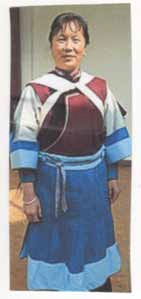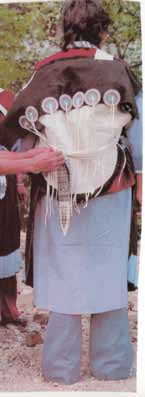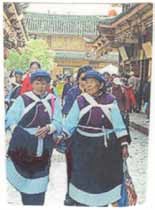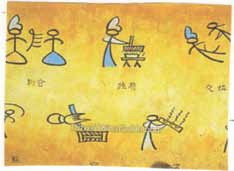
| What is Flavor and Fortune? |
| How do I subscribe? |
| How do I get past issues? |
| How do I advertise? |
| How do I contact the editor? |
Read 13089756 times
Connect me to:
| Home |
| Articles |
| Book reviews |
| Letters to the Editor |
| Newmans News and Notes |
| Recipes |
| Restaurant reviews |
| Article Index (all years, slow) |
| List of Article Years |
| Article Index (2025) |
| Article Index (last 2 years) |
| Things others say |
| Related Links |
| Log In... |
| Authors |
| Categories & Topics |
Naxi: A Minority with Many Names
| by Jacqueline M. Newman |
Chinese Ethnic Minorities and Their Foods
Winter Volume: 2018 Issue: 25(4) pages: 16 to 19
Most of this Chinese ethnic minority live in the Yunnan Province in the Naxi Autonomous County in Lijiang. Smaller numbers live in southern Tibet and in the Sichuan Province. A few do live in Vietnam and in Thailand, and very few live in Beijing.
Many are farmers, only a few understand the pictographic Naxi language and no computer or typewriter does or can deal with this Dongba language.

Naxi speak a Sino-Tibetan-Burmese language related to Geba. In 1957, with government help, about half million did learn to transcribe their language using Chinese characters or Latin letters so they could use computers and typewriters. Dongba written pictographic language is still in use, but mostly to write a sutra, mantra, or another religious item. See this on the next page.
Their population, can also be called Nakhi or Nashi, once they were known as Mosha-yi or Moxie-yi, even Mosou. The Chinese government counts these groups as one for the census, the word na means senior, xi means people. Most of them easily communicate with their neighbors, something less common in their past.
This ethnic population does not see themselves as one population, and as they are mostly rural farmers, they live well-separated and isolated, many in the Himalayan foothills, in the Northwestern part of Yunnan, the Sichuan Province, or in southern Tibet. Most believe they are descendants of nomadic proto-Qiang folk who moved south to the banks of the Nujiang and Jinsha Rivers. Some of them say they originated in southern Tibet while others say they came from northwestern China. There seems to be little agreement as to where they did come from.
Current population counts include Mosuo people who have their own language, writing, and native dress. Nonetheless, the Chinese government still groups them as one though they do not see themselves that way.

Most Naxi are led by religious folk, many part-time priests who teach them to believe they were born from spirits that never die, have relationships between man and nature, need to practice fengshui, and since the tenth century, have female shamans who practice divination, exorcism, and go into many trances. Few have places of worship, rarely see others who practice their religion, and many do believe trees encountered bring them bad luck.
Naxi who do not live near them play similar music, celebrate the same spirits, and do so on snake or dragon days. They believe their ancestors came from heaven, they respect Shu gods and have a God of War who wears a white helmet and rides a white horse. He was born in the Year of the Goat. Almost all Naxi enjoy the Torch Festival, tell us they come from traders or emperors, and that they once traded with, and think they came from spirits.
Most live in remote areas, and there are only a few who are urban dwellers. Many do live in the town of Dayan, the seat of the Lisang Naxi Autonomous County. They believe their culture was founded by Dongba priests a thousand or more years ago with the oral language they use and the written one they use in their religious writings including the epic sutra about fishing, hunting, weaving, and war with their Puma.
Their religion is a form of shamanism mixed with folk beliefs. Some of them sing it, others dance it, and still others tell us they do not know but do see or hear about it only at weddings or funerals. This could be because they live among one and a half million Bai, the same number of Dai, half that number of Va, and only one and a half thousand Jingpo in the Yunnan Province, and fewer Naxi than any one of these populations.
Naxi are concentrated in the town of Dayan, a remote place where the women wearing unlined long garments with wide sleeves, and trousers under multi-pleated aprons. The back of their tops often has a design of the Big Dipper, the Sun, the Moon, and/or seven stars with tassels hanging from them. Men’s clothing is plain with no decor.
One Naxi family told us they celebrate many Han holidays as well as their own including their Naxi Farm-tool Festival in January, their Dragon-king Fair in March, their Mule and Horse Fair in July, and other lesser holidays.

When we first walked into one Naxi home, the hostess served us squash seeds and tea in a wooden bowl. In another, these were served by a host; and we did not learn if either was typical. In a third, both host and hostess did apologize that they had no wooden bowls for tea because they had a kitchen fire a few weeks earlier. When we asked if they always use bowls for tea, they did not answer, so we never learned why that comment. We did ask if they use the bowls for breakfast; and they said no because they usually only have steamed bread then. For lunch and dinner, they often serve pickled pork but they had none then even though it can last without refrigeration for years. We never learned the reason they mentioned it but had none to offer us.
They did talk about dinner when they eat a baked pie that is not filled. They served us a pickled cabbage vegetable soup, some cured meat, and some steamed rice, all on big flat plates. The meat was dried and in very big pieces. We did not learn if this is a typical evening meal but were told they like belly pork with black mushrooms and piquant peppers, spicy fish dishes, doufu with wild vegetables they call jue yin, and eggplant with sesame seeds soaked in vinegar. We did eat three meals with three different Naxi families, always had yin jue, a special yellow Naxi sweet wine from rice buried in flasks dugout when needed at all three meals, but not one of the dishes mentioned.
One Naxi family in Lijang did serve us wheat rolls called Naxi bread, and chickpea noodles they called ‘Rock Bridge Noodles.’ These were at meals with soybeans, scallions, chili peppers, and vinegar; and they were pickled. The liquor was home-made and fiery, already on their tables, and with a dish of cooked bean curd. It was, they said, served at banquets, weddings, and funerals.
All three meals had three dishes, all were the same, the first dish was always sweet, the second had lots of chicken as the protein, the third was a thick soup with corn and rice. They told us their staple foods are rice, maize, wheat, potatoes, and beans.
Some of the families we ate with were Daoists, others Buddhists. We did try, but to no avail, to discuss their food and their religious beliefs. In one home, they served a plate of candied cakes made with popped corn and roasted walnuts, in another the pork was very fatty and did look and taste like chicken. We did ask about that, but they could not explain why. This family said they raise their own food, and when we tried to learn what these foods were, they looked embarrassed and said no more.
Did they not understand; or were they prompted about what they could tell us? Or had the food been sent in as they could not answer our many food questions? Were they nomadic folk like the ones we did see? Wonder about? One thing we did notice in all three homes was the low front door. It required every one of us to bend to get in and out. We did ask about this but learned only a little about that.

They did tell us bending low is to “honor their god”. It is traditional to serve eight dishes to guests, but they apologized for their meager offerings. We did wish we had recipes and could make some of the foods, but we did not get any answers about what was in many of them. They did tell us they are monogamous, do not practice walking marriages which are the only vestige of their matrilineal life-style.
Interestingly, every family did want to give us some food to take, but going to a hotel, we said thank you, but not on this visit, and did thank them profusely for their hospitality. They looked uncomfortable when we did. Below is the only Naxi recipe we found in a Chinese cookbook. It does taste close to foods we were served.
| Pickled Naxi-Style Spiced Ribs |
|---|
2 pounds of spare ribs
1. Cut the ribs into individual pieces, then mix them with
the rice wine, sugar, peppercorns, whichever crushed
pepper used and let the ribs rest for two hours.
|


Copyright © 1994-2025 by ISACC, all rights reserved
Address
3 Jefferson Ferry Drive
S. Setauket NY 11720